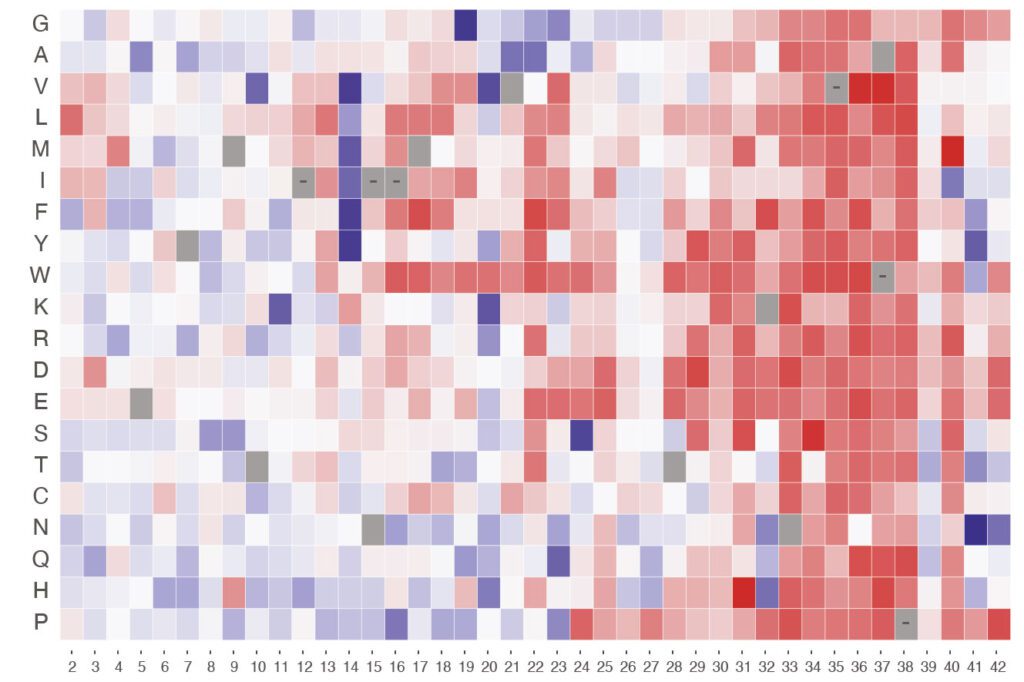Researchers from the Institute for Bioengineering of Catalonia (IBEC) have developed the most complete atlas up to date of the genetic mutations that cause the formation of amyloid beta fibril, a protein implicated in Alzheimer’s disease. The study, led by IBEC’s researcher Benedetta Bolognesi, in collaboration with the Ben Lehner’s group at the Centre for Genomic Regulation (CRG), has been published in the prestigious scientific journal Nature Communications.

Amyloid fibrils are aggregates of proteins that accumulate around cells, without the organism being able to decompose them. Its presence and formation process are the hallmarks for more than 50 human diseases, including Alzheimer’s disease, Parkinson’s disease, frontotemporal dementia, amyotrophic lateral sclerosis, and type II diabetes.
Researchers have already managed to discover the structure of several amyloid fibrils. However, the mechanism in which they are formed, known as nucleation, is still a mystery. Understanding this mechanism is fundamental to prevent some of the main pathologies that affect society.
With deep mutational scanning, a high-efficiency cell analysis technique, it is possible to characterise thousands of genetic mutations that produce amyloid protein aggregation. Until now, techniques for exploring deep mutations tended to only observe “substitutions” (mutation in which a building block of DNA replaces another), largely ignored other type of mutations such us “insertions” (mutation in which a building block is added) or the “deletions” (mutations in which a whole building block is deleted), even though both mechanisms may be determinant for the accumulation of amyloid.
Mireia Seuma, researcher at the group of Benedetta Bolognesi at IBEC, has managed to develop a full atlas that compares multiple types of mutations and evaluates its role in the formation of amyloid fibrils. Her work was recently published in the prestigious scientific journal, Nature Communications.
Mutations that make you sick
The study in question analysed a peptide formed of 42 amino acids, identifying 307 mutations that increased amyloid accumulation, a 10% of the total amount of mutations detected, among which were many that did not correspond to “substitutions”, but to alterations such as “insertion” and “deletion”. On the other hand, the high number of identified mutations in this short peptide reveals the enormous diversity of variations that can occur in the human genome. These mutations may or may not result in disease, highlighting the need-to-know which type of impact they have on amyloid nucleation.
Besides, researchers observed that the 87% of the mutations with a high probability of being pathogenic are found in a specific extreme of the peptide, known as N-terminal. The truncations of this region turned out to be highly effective at speeding up nucleation and therefore, it is expected that this region plays an important role in the development of Alzheimer’s.
Taken together, this work provides comprehensive guidance for future clinical interpretation of mutations and is a very useful tool for researchers conducting basic and clinical research on all disorders that underlie amyloid aggregates.
Reference article: Seuma, M., Lehner, B. & Bolognesi, B. An atlas of amyloid aggregation: the impact of substitutions, insertions, deletions and truncations on amyloid beta fibril nucleation. Nat Commun 13, 7084 (2022). https://doi.org/10.1038/s41467-022-34742-3





